
MAY CONTAIN NUTS

Search Shorpy
SHORPY ART

Framed or unframed, desk size to sofa size, printed by us in Arizona and Alabama since 2007. Explore now.
Join and Share
Ad-Free Shorpy
Shorpy is funded by you. Patreon contributors get an ad-free experience.
Learn more.

Recent comments
- The Last Bickford's
- Re: And literally just around the corner
- Straight from Central Casting
- And literally just around the corner
- How did Vachon do it?
- Clean on the outside
- You write Bickfords, I write Bickford's
- Clean Outside In
- Don't interrupt the photographer
- Immortalized for Posterior
- Still standing on Fayette Street
- Takin' Care of Business
- Balt Noir
- Joke
- I Wish
- Texas Landscapes
- Unfun
- Not just one
- Dress Code
- Status
- Brakeman?
- A couple of Stormy Kromers
- ¿Por qué dos locos?
- Oklahoma
- Dos Locos
- Double Header
- Wagon Top!
- It really is that flat
- Time Travel
- Now I know
Member Photos
The Shorpy
Printporium
Printporium
Search Shorpy
Search results -- 30 results per page
- I'm Baaaaad: 1920
- ... 712 12th Street NW in Washington. He sold snakes to Alice Roosevelt Longworth. Under the sign "this pig slept last night in the White ... the sale of a pig for young Quentin Roosevelt after the president's son had snuck it into the White House, only to have it discovered. ... Posted by Dave - 01/23/2014 - 10:18am -
![I'm Baaaaad: 1920 Sept. 3, 1920. Washington, D.C. "Wap-See-Ho-Hong." We leave it to our resourceful commenters to fill in the blanks. National Photo Co. View full size.
The Horn of a dilemma?Getting "butted" by this fellow would sure be a new twist!
Bad Is Right!Unless my eyes are deceiving me, it appears that this may be the first picture on SHORPY of anything, man or beast, relieving itself.
[That's hay. - Dave]
Baaaad Job!Looks like one of Morning Glory and Oberon G'Zelle's semi-successful experiments!
HmmSomehow the term "animal glue" comes to mind.
Sheep. Why'd it have to be sheep?I'm much better at identifying goats. But it looks like our friend here may be related to a Jacobs Sheep. They have some whackadoodle horns.
Could it be?The fabled ramoceros.
Picture?Who in their right mind would stop, see, then set up the camera to take a picture of something only a mother could love?!!!!
[The National Photo Company was a commercial photography firm which, in the words of the Library of Congress, "supplied photographs of current news events in Washington, D.C., as a daily service to its subscribers. It also prepared sets of pictures on popular subjects and undertook special photographic assignments for local businesses and government agencies." -tterrace]
The Great Wolf Slayer
Washington Post, June 8, 1918.
Masonic Notes
…
Grand Monarch Edward S. Schmid is to take a hand with a curiosity which he found in southern Texas on his recent trip there. It is a handsome goat with the usual accompaniment of side horns, but with a spike sticking from the top of his head which makes him unique. Grand Monarch Schmid calls his pet “Wap-See-He-Hohong,” which he says means “the great wolf slayer.” …
Schmid's SheepEdward S. Schmid (like his father and grandfather, and later his son, Edward L. Schmid), sold small animals a short distance from the White House. He was the proprietor of Schmid's Bird and Pet Animal Emporium at 712 12th Street NW in Washington. He sold snakes to Alice Roosevelt Longworth. Under the sign "this pig slept last night in the White House," he brokered the sale of a pig for young Quentin Roosevelt after the president's son had snuck it into the White House, only to have it discovered. He seems to have been a generous man; he included in his store's catalog instructions for the treatment of rabbits with colic, constipation, sniffles or influenza, and published a phamplet on how he chose his canaries. A freemason and member of associations such as the Association of the Oldest Inhabitants and National Tuberculosis Association, the elder Schmid's donated records take up 25 linear feet in the archives of the Historical Society of Washington D.C.
[Also, this article from the The National Humane Review, October, 1918. -tterrace]
(The Gallery, Animals, D.C., Natl Photo)](https://www.shorpy.com/files/images/SHORPY_02213u.thumbnail.jpg)
- Oyster Bay: 1908
- September 1908. "Invited guests going to Roosevelt house on foot and by carriage" at Sagamore Hill, the president's estate near Oyster Bay, Long Island. View full size. 5x7 glass ... Posted by Dave - 12/10/2007 - 6:17pm -
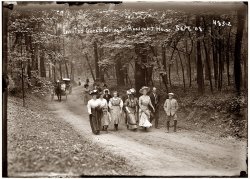
- Country Store: 1940
- June 1940. "Mr. Keele, merchant and president of the Farm Bureau, in front of the general store. Pie Town, New ... 88 (called the Apache Trail) from Apache Junction to the Roosevelt Dam. It's mostly known for the white knuckle drive on a ... Posted by Dave - 06/15/2020 - 3:26pm -
![Country Store: 1940 June 1940. "Mr. Keele, merchant and president of the Farm Bureau, in front of the general store. Pie Town, New Mexico." Medium format negative by Russell Lee. View full size.
Where the sidewalk endsIn a more litigious time, the boards constituting a walkway outside the store would be an ambulance chaser's dream. Have a nice trip! See you next fall. Now lawyer up.
Amarrilla by morningup from Pie Town.
I hope somewhere in the world there are places still this simple and quaint.
TobaccoThis sure makes me glad I stopped smoking.
Lowering the Boom"Dammit Jenkins, if I've told you once, I've told you a thousand times: keep that boom mic OUT of the frame!"
While this is probably just a furtive finial, it's important to keep Jenkins on his toes!
[Or could it be a light bulb? - Dave]
Going to Fish CreekThere are some misspellings on the sign showing locations in Arizona. McNarry should be McNary, and Miama should be Miami, a copper mining town near Globe. The most interesting is Fish Creek, along Arizona Route 88 (called the Apache Trail) from Apache Junction to the Roosevelt Dam. It's mostly known for the white knuckle drive on a precipitously narrow dirt road down Fish Creek Hill. When I moved to the area 40 years ago, driving down Fish Creek Hill was considered a rite of passage for greenhorns!
Here's a nice picture of the road in the area of Fish Creek:
Daniel Fahrenheit's InventionMercury reads around 78 degrees Fahrenheit. Long pants and long sleeves optional. Hat required.
Open 24 hours?Where is the door??
[The doors are open. - Dave]
Country Store colorizedClick here to watch Jordan J. Lloyd colorize the photograph taken a few moments earlier (?), from start to finish. In the past I did some colorizing of Shorpy pictures myself, e.g. this or this, but having seen this pro at work, I think I better quit, or learn it myself of course, I would like to, I admit.
Pie Town is still a great placeIt's well worth the drive off I-25 in Socorro, past the VLA telescopes, thru Datil (great general store/restaurant), to the Pie-O-Neer cafe, which opens at 11:30 am. Fabulous pie, terrific people! A few old buildings are still standing; don't know if any of them have been shown in this series.
Las Vagas?That's 281 miles to New Mexico's Las Vegas. Nevada's is 500 miles. But neither is spelled "Vagas," and the longer the drive, the more numb one's vagus.
Seventeen ads for tobacco productsBut only two are for “tailor mades.” Folks round those parts chaw plug or leaf, puff a pipe, or roll their own.
(The Gallery, Pie Town, Russell Lee, Small Towns, Stores & Markets)](https://www.shorpy.com/files/images/SHORPY-8b25367a.thumbnail.jpg)
- Welcome to the White House: 1908
- ... Calls.
The 300-pound presidency It's a cinch that President Taft never sat in any of those chairs.
Tattered rug Note how ... If this wasn't just "circa 1908," but 1908, Teddy Roosevelt would be in his final full year as president. This shot matches the ... Posted by Dave - 08/27/2012 - 4:21pm -
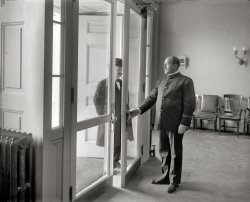
- The Miantonomoh: 1892
- ... America began to catch up with the big boys. Having Teddy Roosevelt, former Assistant Secretary of the Navy, as president certainly aided its progress.
(The Gallery, Boats & Bridges, DPC, ... Posted by Dave - 07/07/2022 - 12:39pm -
![The Miantonomoh: 1892 The Hudson River, 1892. "U.S. double turret monitor Miantonomoh." Named after the Narragansett chief. 8x10 inch dry plate glass negative by Edward H. Hart. View full size.
Often overlooked.As it were. In every sense. Yet somehow managed to survive 45 years (at least if you count from the launch date, not the 6-year-long - !! - fitting-out period)
Low freeboardLooking at that, you'd suspect the least wave would swamp it. However, it made it across the Atlantic and back.
[You're confusing this ship with the first Miantonomoh. - Dave]
In and Out of ServiceUSS Miantonomoh (BM-5) was the second ship to carry the Narragansett sachem's name. She was one of four ships of the Amphitrite-class of monitors. She was commissioned and decommissioned four times during her life which has to be some sort of record for US Navy ships.
Retirement AgeThe continued use of Civil War-era technology helps to explain why the U. S. Navy was rated well below that of several nations which would not even make the Top Ten list today. It would not be until the early 20th Century that America began to catch up with the big boys. Having Teddy Roosevelt, former Assistant Secretary of the Navy, as president certainly aided its progress.
(The Gallery, Boats & Bridges, DPC, E.H. Hart, NYC)](https://www.shorpy.com/files/images/SHORPY-4a13907a.thumbnail.jpg)
- Beer Boulevard: 1938
- ... decision was one of two in early spring 1937 that signaled President Roosevelt (and a switch by Justice Owen Roberts) had tipped the Court's balance ... Posted by Dave - 11/26/2017 - 12:49pm -
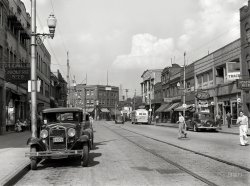
- International Newsreel: 1924
- ... harder to handle. Mr. Van Tine wanted to get a photo of President Wilson basking in the sun on the White House lawn, so he hid in a ... secretary-treasurer.
Mr. Van Tine, who lived at the Roosevelt Hotel, 2101 16th st. nw., is survived by two granddaughters, Mrs. ... Posted by Dave - 02/09/2012 - 1:52pm -
![International Newsreel: 1924 Washington, D.C., 1924. "Van Tine & Johnson." Harry Van Tine and Joe Johnson in a photographic survey of Washington-area lensmen. View full size.
International Newsreel Corp.That's confusing - if they're newsreel lensmen, why the still cameras, a 4x5 Graphic and 5x7 Graflex? I'll need to dig into this one.
[International Newsreel was a photo agency whose pictures appeared in many newspapers. - Dave]
Perfect typesThese look exactly like the guys you would see in a 1930s movie, brandishing flash cameras, with a card reading "Press" stuck into their hatband.
Graflex shootersThe camera between them appears to be an early Graflex single lens reflex.
Walking all over town those shoes could use a spit shine.
Could it be Lincoln's church?The building in the right background is the old Masonic Hall on New York Avenue, which would seem to put these two gentlemen on the roof of the old New York Avenue Presbyterian Church, the church attended by Abraham Lincoln, which was torn down in 1950. I'm not sure where they'd fit up there, however--possibly on a ledge on the clock tower? Perhaps it's more likely that they're on the roof of one of the buildings nearby on H Street, such as the Times-Herald Building, which would be very fitting.
Pappy Van Tine
Washington Post, May 2, 1968.
Lensman Harry Van Tine Dies.
Harry M. Van Time, who snapped exclusive photos of Harry K. Thaw escaping from a mental institution in 1915 and took the first still pictures of actress Mary Pickford, died Tuesday at Washington Hospital Center after a two-month illness. He was 82.
Mr. Van Tine, known throughout his professional life as "Pappy" and "Van," retired in the 1950s after 40 years with International News Photos. He was dean of the White House News Photographers Association and one of its founders.
Born in Beacon, N.Y., he was working for a newspaper chain in the Hudson Valley when Thaw, who had murdered the famous architect, Stanford White, escaped from Matteawan State Hospital.
His photos helped him to land a job in New York soon after that and by 1914 he was working for INP, covering championship boxing matches, taking photos from early and makeshift airplanes, and photographing Barney Oldfield winning the Sheepshead Bay auto race.
He took still photos of Mary Pickford when she was a young girl appearing in "The Call [Song] of the Wildwood Flute" and he was there with his camera when a midget was planted into J.P. Morgan's lap.
Mr. Van Tine came to Washington in 1917 on assignment, covering the arrival of French Marshall Joffre and Italian Minister Marconi, and decided INP needed a Washington bureau. He became that bureau and was with it from then on.
Things were more casual then around the White House and the photographers harder to handle. Mr. Van Tine wanted to get a photo of President Wilson basking in the sun on the White House lawn, so he hid in a load of hay that was headed for sheep which then grazed behind the White House. But he was discovered by Secret Servicemen.
Mr. Van Tine was the first vice president of the White House News Photographers Association. He served later as president and was for ten terms the organizations secretary-treasurer.
Mr. Van Tine, who lived at the Roosevelt Hotel, 2101 16th st. nw., is survived by two granddaughters, Mrs. Cyril J. Pittack, of 601 Four Mile rd., Alexandria, and Mrs. Al Kimbrough, of Reno, Nev.
Van Tine's cameraHarry Van Tine was my great grandfather. We still have that camera.
Thank youThis is the first time I have been able to see my Great Grandfather Harry
(The Gallery, D.C., Natl Photo)](https://www.shorpy.com/files/images/SHORPY_11324u.thumbnail.jpg)
- Machine Shop
- ... became official 4 July 1896 . Thomas Reed also ran for President in 1896 (losing the nomination to McKinley). The 1896 Republican ... and politicians Sen. Henry Cabot Lodge, Theodore Roosevelt, Henry Adams, John Hay and Mark Twain.
Interesting and funny ... Posted by John.Debold - 09/21/2011 - 9:15pm -
![Machine Shop On close inspection, I see a McKinley political sign. So would that be just before the turn of the century? View full size.
"Machine shop"These are linotype operators in a newspaper pressroom.
1896The 45-star flag became official 4 July 1896. Thomas Reed also ran for President in 1896 (losing the nomination to McKinley). The 1896 Republican convention was in June, I would guess flag makers (and the linotype shop) got an early jump on the new flags.
[The flag in the photo has 44 stars, not 45. - Dave]
LinotypeIn the 1950s my Uncle George Percy Gaskill of Barnegat, New Jersey, was the plant manager for Sleeper Publications in Mount Holly. I visited several times to observe his operation of the Linotype there. It was used to cast molten lead into "slugs," one for each line of type ("linotype")in a newspaper column. I have a couple of inserts that he made for me with my name.
Thomas ReedI was curious why this shop displayed both primary candidates, which led me to wikipedia. But I was soon distracted on the political story when I saw this about Thomas Reed...
He was known for his acerbic wit (asked if his party might nominate him for President, he noted "They could do worse, and they probably will"; asked if he would attend the funeral of a political opponent, his response was "no — but I approve of it"). On another occasion, when a fellow congressmen declared that he would "rather be right than the president," Reed coolly replied that the congressman needn't worry, since he would never be either. His size -- over 6 feet in height and weight over 300 pounds -- was also a distinguishing factor. Reed was a member of the social circle that included intellectuals and politicians Sen. Henry Cabot Lodge, Theodore Roosevelt, Henry Adams, John Hay and Mark Twain.
Interesting and funny man with some notable acquaintances.
[Reed and McKinley weren't "primary candidates" -- state presidential preference primaries didn't exist in 1896. The two were contenders for the Republican nomination at the party's national convention. - Dave]
IntertypeIf you look at the man on the left, closest to the camera, just to left of his head is a shaft inside a large spring. This indicates the these machines were Intertypes a typesetting machine very similar and in someways superior to the Linotype. How do I know? I spent my apprenticeship operating linotypes, and later in Australia spent some time on Intertypes. The shaft was attached to a plunger that pumped molten typemetal that cast the lines of type or slugs.That machine room would have been very noisy!
Linotypes, not Intertypes.Sorry, these can't be Intertypes, as the first Intertypes weren't in production until 1917.
Both Linotypes (some models, some years) and Intertypes had the vertically mounted spring for the pot plunger, it wasn't until much later that Lintotype moved that spring into the column. The actuation was slightly different as ll, as you can see on my 1922 Intertype.
From here:
"Original pot plunger spring on Linotype Model I was positioned directly above plunger lever to exert a straight downward action. Intertype continued this method as the patent must have run out by 1912. The Intertype spring pressure is released by simply unscrewing a rod straight up. Linotype "improved" their machine by a system of levers to put this spring inside the column. This worked until a stronger spring was necessary to cast larger slugs and improve faces for reproduction proofs. I remember a time in Santa Rosa, California, when it was a three-man job to put that heavy spring back in place on a Model 8 Linotype."
etaoin shrdlu cmfwyp vbgkqj xz
(ShorpyBlog, Member Gallery)](https://www.shorpy.com/files/images/Desoto0002.thumbnail.jpg)
- K.C. Club: 1906
- ... of Lincoln's funeral procession. Six-year-old Theodore Roosevelt and brother Elliot look down as the dead president moves past their grandfather's house in New York City.
Club Stats ... Posted by Dave - 05/25/2022 - 2:10pm -
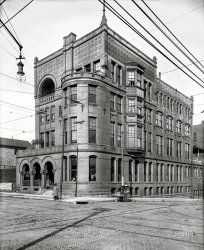
- Hoover Terminal: 1942
- ... when he was Secretary of Commerce prior to being elected President. It's not surprising that when President Roosevelt announced plans for Washington National Airport in 1938, the Hoover ... Posted by Dave - 09/23/2021 - 6:38pm -
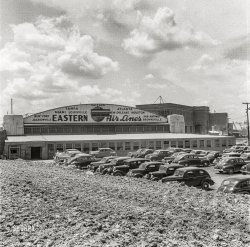
- Portrait of a Prodigy: 1933
- ... Perkins gave a solo recital in New York, Franklin D. Roosevelt was in his second term as President, and the violinist was a 12-year-old prodigy. Sunday afternoon she ... Posted by Dave - 08/28/2012 - 3:11pm -
![Portrait of a Prodigy: 1933 Washington, D.C., 1933. "Miss Gloria Perkins, portrait." As a 10-year-old violin prodigy, Gloria played with the National Symphony Orchestra. View full size.
Time for GloriaIt seems she made Time magazine back in the day.
Gloria Perkins, 10, whose mother is a church organist in Queens Village, Long Island, and whose father, Clemmett Birdsong Perkins, is Eastern Passenger Agent for the Norfolk & Western Railway Co., played the Mendelssohn Concerto with the National Symphony in Washington. Gloria is a wispy little girl who wears big hair ribbons and oily black corkscrew curls. She took so long to tune her violin that the audience started to titter. But the feeling rapidly changed as the Concerto got under way. Gloria was not only technically expert but her playing had a simple persuasive quality that touched the audience deeply. Father and Mother Perkins are making a pianist of their son, Clemmett Birdsong Perkins Jr., 3.
Little Girl BlueThe little details of her crucifix and ring make her look like she's posing for a communion picture with an incidental instrument.
Not sure I would have appreciated the "oily black corkscrew" comment in Time. Her poor hair looks like it would really prefer to frizz and/or be left alone. Possibly like the girl herself; she looks a little sad.
Young Soloist
Washington Post, Nov 12, 1933
Child Artist Makes Debut at Symphony
Young Soloist Will Play Mendelssohn Concerto This Afternoon
Gloria Perkins, an exceptionally talented child violinist will maker her debut as an orchestral soloist in Washington this afternoon, playing a Mendelssohn Concerto with the National Symphony Orchestra, under the direction of Dr. Hans Kindler. She is a pupil of Louis Persinger, who succeeded Leopold Auer as head of the violin department of the Julliard Graduate School.
Gloria was born ten years ago in Winston-Salem, N.C., and has lived in New York since she was 2. At the age of 4 she played the piano with surprising ability and when she was 6 she began the study of violin with her mother. Her progress was so remarkable that she was placed under the tutelage of Mr. Persinger who had instructed Yehudi Menuhin and Ruggiero Ricci.
Gloria Perkins Returns to the StageN.Y. Times, September 25, 1972
Gloria Perkins, Violinist,
Returns to Recital Stage
The last time Gloria Perkins gave a solo recital in New York, Franklin D. Roosevelt was in his second term as President, and the violinist was a 12-year-old prodigy. Sunday afternoon she was welcomed back by a cordial audience that nearly filled Carnegie Recital Hall.
Miss Perkins, who now lives and teaches in Queens, has much to offer as an artist. Her tone is firm and full, her intonation precise, she phrases musically, and her playing has an assertive energy that, when not pressed too relentlessly, produces performances of impressive impact ...
The Wonder YearsWhenever I see this kind of portrait, I always wonder what became of the subject. There's something about this girl's face that especially leaves me filled with unnerving curiosity. The newspaper excerpts are very helpful, but I still wonder: did her parents push her? Did she continue to play? It says she didn't do her next solo again until '72, but did she play for a band? She would be about 86 now. I wonder if she's still alive.
[The 1972 performance was her first solo recital in New York in many years. We don't know if she continued to give recitals elsewhere. - Dave]
My Violin TeacherI began taking private lessons with Ms. Perkins when I was about 5 or 6 years old and continued through junior high school.
She is 88 years old now and is still playing her violin. I grew up in Queens, NY and she still lives in the same house where I took lessons from her. After high school I stopped playing the violin but recently began to play again (I'm now 27). She lived with her brother who passed away, I think a few years ago. She still plays occasionally at weddings and churches and has a couple of students that she is still teaching!
I moved away after high school to attend college and live out of state. However, I have family still in NY and decided to visit her my last trip up (last week). It has been probably since junior high school when I last saw her. She is an amazing woman and is still the exact same lady I remember growing up. A quintessential teacher, passionate about her first love and somebody who lights up a room. She would not let me leave without sifting through her music to find a copy of "Adoration" for me to play, as I mentioned to her I play weddings occasionally. I am a photographer now and took several photographs of her before I left.
A part of me wishes I lived in NY so I could visit her and receive lessons again. An amazing woman.
Your violin teacherWonderful! Thanks for the photo - this truly is a way to make the past come alive. Did you let her know about or show her her photo here on Shorpy and, if so, what was her reaction?
Wonderful update from EricaThat brought a smile to my face.
Thanks especially for the photograph!
(The Gallery, D.C., Harris + Ewing, Music)](https://www.shorpy.com/files/images/12953a.thumbnail.jpg)
- Inauguration: March 4, 1933
- March 4, 1933. "Inauguration of Franklin D. Roosevelt as President and John Nance Garner as Vice President. Podium at U.S. Capitol East ... Posted by Dave - 03/04/2021 - 1:40pm -
![Inauguration: March 4, 1933 March 4, 1933. "Inauguration of Franklin D. Roosevelt as President and John Nance Garner as Vice President. Podium at U.S. Capitol East Portico, Washington, D.C." This 37th presidential inauguration, the first of four for FDR, was the last to be held in March before Inauguration Day was moved to January by the 20th Amendment. Harris & Ewing glass negative. View full size.
Excellent WhiskersChief Justice Hughes, administering the oath, had some classy facial hair. Some politicians today experiment with beards, mostly with embarrassing results.
The View From AboveI'm amazed at all the people up on the roof and standing outside the rotunda. Don't think they allow that anymore!
Administration of the Oath has ChangedIn 1933, Chief Justice Hughes recited the entire Oath. Then, FDR recited the entire Oath, perhaps from memory; it's hard to tell. That practice seemed to end with FDR.
In 1949, Chief Justice Vinson would say a brief phrase ("You, Harry Truman, do solemnly swear -- ") and Truman would repeat the phrase (I, Harry Truman, do solemnly swear -- "). As far as I can remember, that's how it's been done ever since.
Re: WhiskersThose of us fortunate enough to be Shorpy patrons received today an Inauguration detail of this photo, where we get a side view of FDR with his hand raised and a side/rear view of Chief Justice Hughes, his hand also raised high, and the profile of his white moustache clearly visible. (Sign up today to be a patron! Look for the pink Become A Patron rectangle in the right sidebar.)
I'm at a loss ...Any idea what the wired object is next to the two men?
[You? - Dave]
H.H.Looks like Herbert Hoover above the eagle's left wing.
(The Gallery, D.C., Harris + Ewing, Politics)](https://www.shorpy.com/files/images/SHORPY-46870a.thumbnail.jpg)
- Immigrants: 1955
- ... into New York Harbor from Le Havre France. Theodore Roosevelt was the President of the US. On board were Giovanna and her sons Guido and Albino. ... Posted by tterrace - 09/29/2011 - 6:17pm -
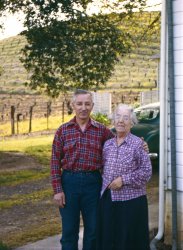
- Post Office Restaurant: 1901
- ... bottle of beer produced by the brewery was delivered to President Roosevelt at the White House on April 14, 1933.
(The Gallery, D.C., D.C. ... Posted by Dave - 10/10/2020 - 7:31pm -
![Post Office Restaurant: 1901 Washington, D.C., circa 1901. "View of D Street N.W., looking west from 12th Street at Pennsylvania Avenue." 5x7 inch glass negative, D.C. Street Survey Collection. View full size.
Hints of ParisThat corner building would look at home in Montmartre.
Back When It Really Was the Post OfficeI'm going to take a flyer here and guess that the restaurant has that name because it is across the street (or at least very near) to the Old Post Office, which is at Pennsylvania and 12th.
[Which at the time would have been the New Post Office. Also known as the Trump International Hotel. - Dave]
Tracing a Structure's PedigreeTake the third building down the street — the one with the large flagpole atop it. As the son of a DC firefighter, I recognized it right away as bearing the unmistakable signature façade of a fire station: driveway with flanking lamps, huge arched front doors, sidewalk chair, and the flagpole. With the help of an 1888 Sanborn Fire Insurance map, I can confirm that this (1204 D St. NW) was indeed the home of DCFD Engine Company 2 up until 1887. At the time this photo was taken circa 1901, Engine 2 had moved to other quarters but the building’s pedigree is still readily evident. More about Engine 2’s history here.
What I wouldn’t give to have been standing in the photographer’s position just a few years prior to when this photo was composed to witness Engine 2, a classic Amoskeag 600 GPM steamer pulled by horses, emerge in all its smoking, gleaming glory and responding to an alarm.
All day breakfastI'll have coffee, three poached eggs on a plate of hash-browns, whole wheat, topped with a roll of "forever stamps", please.
Congress BeerThe Abner-Drury Brewery was in the Foggy Bottom neighborhood of Washington. After Prohibition was repealed the first legal bottle of beer produced by the brewery was delivered to President Roosevelt at the White House on April 14, 1933.
(The Gallery, D.C., D.C. Street Survey, Eateries & Bars)](https://www.shorpy.com/files/images/SHORPY-40252a.thumbnail.jpg)
- Band Ahoy: 1923
- ... guys with their violins and bass fiddles marching with President Harding in Alaska that year. Thee Navy Yard Band became the Navy ... Concert hall. As Assistant Secretary of the Navy Theodore Roosevelt put it, "The U.S. Navy band confirms the belief that the U.S. navy ... Posted by Dave - 08/21/2012 - 12:49pm -
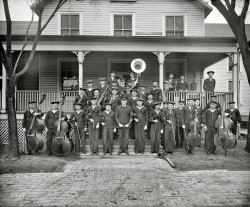
- A Boy and His Dogs: 1928
- ... star of this show is his socks.
Teddy III? Theodore Roosevelt IV (grandson of the the former president, son of Ted, thus known as III) would have been fourteen years old in ... Posted by Dave - 11/01/2013 - 1:11pm -
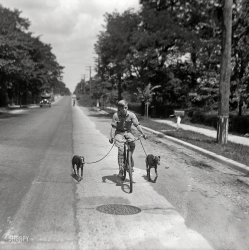
- Potomac Passage: 1861
- ... today, huh?
Mason's Island Presently Theodore Roosevelt Island. That's Georgetown on the other side of the river I would ... the 1841 Mississippi Rifle, designed by the Confederate president, Jefferson Davis, when he was the Colonel of a US regiment from ... Posted by Dave - 03/23/2019 - 10:09am -
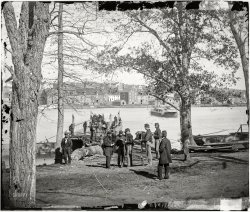
- Fashionistas: 1925
- ... of American Pen Women Heavy Hitters Mrs. Colman was president of the National League of American Pen Women, an arts association that exists to this day. Eleanor Roosevelt was also a member. I'm guessing this was taken at their national ... Posted by Dave - 08/06/2012 - 1:56pm -

- The Wilson: 1908
- ... to a local site:
"... just a couple of months after President Teddy Roosevelt visited, it burned nearly to the ground. Most of the first floor was ... Posted by Dave - 04/22/2013 - 9:36am -
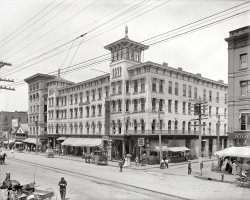
- Eastern v. Central: 1923
- ... a year nationally, but many old fans including former president Teddy Roosevelt lamented the introduction of helmets. They thought it sissified the ... Posted by Dave - 09/03/2012 - 9:42am -
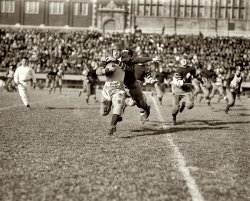
- Ladies, First: 1933
- March 4, 1933. "Lou Henry Hoover and Eleanor Roosevelt in First Ladies' car of Inaugural motorcade. Inauguration of Franklin D. Roosevelt as 32nd President of the United States." Harris & Ewing Collection glass negative. ... Posted by Dave - 07/22/2018 - 8:01pm -
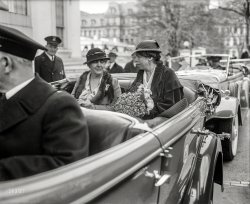
- Restore America: 1939
- ... was designed to attack the Democratic candidate, Franklin Roosevelt, and other stamps in the series depicted FDR as a Frankenstein ... elderly, by pushing through the Townsend Plan if elected President. This particular stamp is doubly ironic, since FDR was a vehement ... Posted by Dave - 09/05/2012 - 8:21pm -
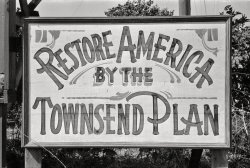
- Sign Here: 1924
- ... exhibits the signatures of five Presidents—Theodore Roosevelt, William H. Taft, Woodrow Wilson, Warren G. Harding and Calvin ... Lord Curzon, the Prince of Wales, Prince Lubormirski, the President of China, Admiral Togo of Japan, J. Pierpont Morgan, a long list of ... Posted by Dave - 02/08/2015 - 1:09am -
![Sign Here: 1924 UPDATE: This is the Croatian-American "world walker" Joseph (Josip) Frank Mikulec. More here and here. And here.
August 6, 1924. "Joseph Frank [illegible] at White House with album for autographs." His pencil, however, was not allowed in. View full size.
Joseph Frank Mikulec
No word on what happened to Joseph’s giant books of autographs.
New York Times, September 2, 1923.
Autograph Collector Here in World Tours
Joseph Mikulec, autograph collector, has covered several hundred thousand miles and twice traveled around the world to get signatures of prominent persons in all countries. In travel-stained clothes and with his huge book strapped upon his back, he went to City Hall a few days ago and got the signature of Mayor Hylan.
After visiting several local celebrities in financial circles, Mikulec started West again. His leather-bound book, which weighs fifty-seven pounds, is the second he has carried to the far corners of the world. In it he proudly exhibits the signatures of five Presidents—Theodore Roosevelt, William H. Taft, Woodrow Wilson, Warren G. Harding and Calvin Coolidge. The book is heavy with seals of many States and cities, and contains the names of Lloyd George, Lord Curzon, the Prince of Wales, Prince Lubormirski, the President of China, Admiral Togo of Japan, J. Pierpont Morgan, a long list of United States Senators, American Ambassadors, Ambassadors to the United States and many editors and noted writers.
Mikulec left his home in Stubica, Croatia, twenty-two years ago, when he was 23 years old, and began his long pilgrimage on foot, traveling from city to city in Central Europe. After several years of incessant travel on the Continent he visited the United States, making his home in Philadelphia and becoming a citizen in December, 1910. Later he returned to his wanderings and visited Australia, New Zealand, China, Japan, India, Egypt, the Holy Land and South Africa.
Mikulec said he was now about ready to settle down. He hoped to see his autograph books placed in a position of honor in a museum. Then, he said, he would get a small farm of his own somewhere in the Middle West.
The Baltimore Sun, July 1928.
Tracking down the Autograph
… The enlightened collector seeks items which stir his feelings for the past. This change in the aim of autograph collecting has been the tragedy of one man, Joseph Frank Mikulec, who twenty-nine years ago started around the world collecting the autographs of the great ones of every land. When he ran out of money he painted portraits, houses and landscapes until he had a stake for his next pilgrimage. As he circumpedaled the globe his album grew until it became a sort of great register of the noted men and women of the nineteenth century. Mikulec developed a set of Atlas-like shoulder muscles from packing his giant album on his back. Finally, when he found himself staggering under the fifty-eight pounds of autographs, he had a perambulator made and today he wheels his life work about. A generation ago his book might have been a treasure, but today dealers are not interested.
Trend SetterAbout fifty years thence, his carry style would make a big hit with owners of portable stereos.
Dream StirringI'm really disappointed the book is missing because this post really piqued my interest. I think to view it would be utterly fascinating the way Mikulec attached notes, photos, seals and postage stamps of the people concerned.
I need to do some researchI'd be interested to see if he's in our family tree somewhere down the line. My dad's parents emigrated from that area back before World War 2.
(The Gallery, D.C., Natl Photo)](https://www.shorpy.com/files/images/SHORPY-26031u1.thumbnail.jpg)
- Lafayette Mall: 1904
- ... looks like a pleasant spring morning toward the end of President Teddy Roosevelt's first term in office.
A lot is still the same That shorter ... Posted by Dave - 02/25/2019 - 5:35pm -
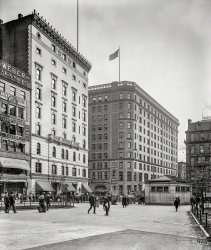
- Pigeonholers: 1924
- ... had borrowed $1.3 billion.) In 1936, Congress overrode President Roosevelt's veto and paid the veterans their bonus years early. - Dave]
... Posted by Dave - 12/28/2013 - 3:37pm -
![Pigeonholers: 1924 November 24, 1924. Washington, D.C. "Bonus Bureau -- Examining Division." The "bonus" was a benefit granted to WWI veterans by the World War Adjusted Compensation Act of 1924. National Photo glass negative. View full size.
Bonus Went UnpaidAnd caused the "bonus riots" in WashDC which were suppressed by army troops led by MacArthur and his aide Eisenhower (yes, THAT Eisenhower).
[The bonus, for amounts over $50, was, by the terms of the original legislation, set to be paid in 1945. The "bonus army" protesters, however, wanted the money right now. (Veterans were able to take out loans against their service certificates beginning in 1927. By 1932, more than 2 million veterans had borrowed $1.3 billion.) In 1936, Congress overrode President Roosevelt's veto and paid the veterans their bonus years early. - Dave]
(The Gallery, D.C., Natl Photo, The Office)](https://www.shorpy.com/files/images/SHORPY_12633u.thumbnail.jpg)























